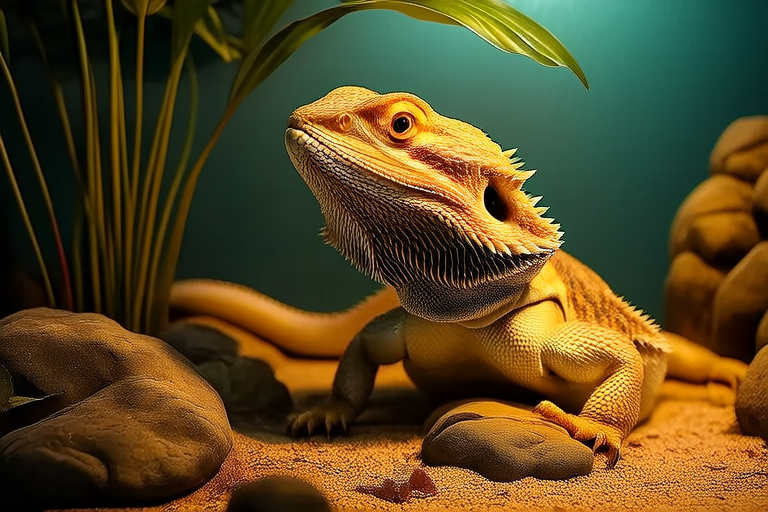Bearded Dragon Care: Essential Tips Every Owner Needs to Know
Welcome to the wonderful world of bearded dragons! (Pogona vitticeps) These captivating reptiles have become one of the most popular pets globally due to their docile nature, vibrant colors, and relatively easy care requirements. Whether you’re a first-time owner or a seasoned handler, this guide will provide you with essential tips to ensure your bearded dragon thrives in its environment.
Diet: Fueling Your Bearded Dragon’s Growth
Feeding your bearded dragon correctly is crucial for its health and longevity. A balanced diet consists of both plant matter and protein, tailored according to age.
- Young Dragons: Offer crickets and other small insects daily. Dust these with calcium and vitamin D3 supplements to promote healthy bone development.
- Adult Dragons: Gradually shift towards a diet that includes more vegetables and fruits, while still providing occasional insects. Leafy greens like collard greens, mustard greens, and turnip greens are excellent choices.
Ensure fresh water is available at all times, but remember, bearded dragons may not drink from a bowl. Some owners mist their dragons’ enclosures to encourage drinking.
Habitat Setup: Creating a Safe and Comfortable Home
The right habitat is key to keeping your bearded dragon happy and healthy. Here’s how to set it up:
Size Matters
A minimum enclosure size of 48 inches long by 24 inches wide by 24 inches high is recommended for a single adult bearded dragon. Larger enclosures are always better, especially if you plan on keeping multiple dragons.
Lighting and Temperature
Proper lighting and temperature gradients are vital for your dragon’s health. UVB lighting is necessary for calcium absorption and overall well-being. Use a 10% UVB bulb placed no further than 12 inches from the basking spot. Ensure the light provides adequate UVA as well, which can enhance mood and activity levels.
Temperature gradients should range from 75-85°F on the cool side to 95-105°F on the hot side. A basking spot of around 105°F is ideal. Monitor temperatures with digital thermometers and invest in a thermostat to regulate heating elements.
Handling Tips: Building a Bond with Your Dragon
Handling your bearded dragon regularly can help it become comfortable with human interaction. Always wash your hands before and after handling to prevent the spread of bacteria.
When picking up your dragon, gently scoop it from underneath, supporting its entire body. Be careful not to squeeze too tightly. Let your dragon get used to being handled gradually, starting with short periods each day.
If your dragon puffs out its beard or darkens its color, it might feel threatened. Give it some space and try again later.
Health Concerns: Keeping Your Dragon Happy and Healthy
Regular veterinary check-ups are essential for maintaining your bearded dragon’s health. Signs of illness include lethargy, loss of appetite, or changes in stool consistency.
Metabolic Bone Disease (MBD) is a common issue caused by inadequate calcium intake or insufficient UVB exposure. Symptoms include softening of the bones, tremors, and difficulty moving. Ensure proper supplementation and lighting to prevent this condition.
Respiratory infections can occur if the humidity level is too high or if your dragon is exposed to cold temperatures. Keep the humidity between 30-40% and avoid sudden temperature drops.
Common Behaviors: Understanding Your Dragon’s Actions
Bearded dragons exhibit several interesting behaviors:
- Basking: They love to bask under heat lamps, which helps them digest food and maintain their body temperature.
- Gaping: This behavior, where the mouth remains open, is often a sign of overheating. If your dragon is gaping, move it to a cooler area.
- Head Bobbing: Male dragons perform this action to show dominance or attract females.
Understanding these behaviors can help you better interpret your dragon’s needs and respond accordingly.
Practical Advice for New Owners and Experienced Handlers
For new owners, patience is key. It takes time for your dragon to adjust to its new home and trust you. For experienced handlers, continually learning about advancements in reptile care ensures your pet receives the best possible care.
Join local reptile clubs or online forums to connect with other enthusiasts. Sharing experiences and advice can be incredibly valuable. Always research thoroughly before making significant changes to your dragon’s care routine.
Conclusion
Raising a bearded dragon can be an enriching experience filled with joy and discovery. By understanding their dietary needs, setting up a suitable habitat, handling them properly, monitoring their health, and recognizing common behaviors, you can ensure your bearded dragon leads a long, healthy, and fulfilling life. Remember, every dragon is unique, so adapt your care approach based on individual needs.
With dedication and love, you’ll create a strong bond with your bearded dragon, turning it into a cherished member of your family.
